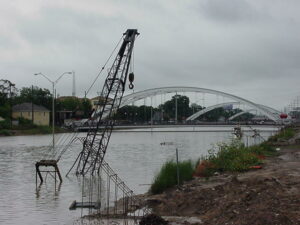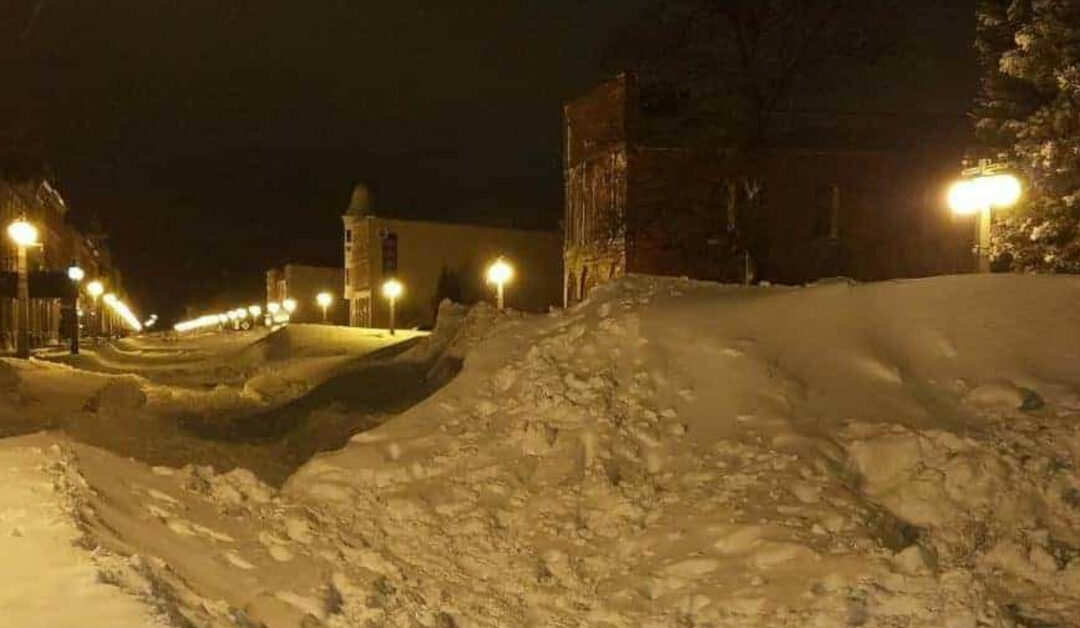April 13, 2018: Blizzard Evelyn swept into North Eastern Wisconsin and Michigan’s Upper Peninsula with more than two-feet of snow, closing businesses, churches, and airports. In this image by Lori Scaggs of Menominee Michigan, the street is buried in drifts up to 10 feet high and remained impassable for days until the town dug out snow with heavy equipment and hauled it away.
Photograph © Lori Scaggs. Used by permission.
Spring Weather
From a scientific standpoint, spring in the Northern Hemisphere begins with the equinox—usually March 20th or 21st—when day and night are nearly equal.
In a more practical sense—depending on where you live—spring begins near the end of February and continues through May and for some, into June. The days continue to grow longer until the solstice on June 20th or 21st, which marks the first day of summer.
Spring Hazards

Tropical Storm Allison flooded Houston with up to 40 Inches of rain and an 8-foot storm surge.
Image Credit: NOAA/NWS Houston
Spring is a period of change that often produces some of the most turbulent, strange, and sometimes even violent weather. Possibilities run the gamut from tornadoes and ice storms to late blizzards and early thunderstorms. The first heat waves affect some parts of the country.
Hurricanes and tropical storms become more likely along the Gulf and Atlantic Coasts near end of May as the start of the Atlantic Hurricane Season begins on June 1st. Before that happens, the Eastern Pacific Hurricane Season starts on May 15th. Both seasons end on November 1.
Note: Don’t discount tropical storms. They get less press and television coverage, but can drop enormous amounts of rain in just hours and leave flash floods in their wake.
The National Weather Service promotes a three-step preparedness plan: Know Your Risk, Take Action, Be a Force of Nature.
Travel
Keep the winter emergency kit in the car until spring’s bluster is well past. Even if you’re not planning on travel, it’s not hard to get caught by surprise. In 2015, a heavy March snowstorm dumped up to 25 inches of snow in Kentucky and stranded commuters and travelers in their cars, many for more than 24 hours.
On one stretch of I-65, the nearby McDonald’s closed their doors because they ran out of food after serving motorists who walked over from the Interstate. Others made do with candy bars and snacks. Some scooped snow into containers to melt for water.
Spring thaws mixed with heavy rains can turn into floods. Small streams overflow their banks and can quickly cover roads. If you see water moving across a road, don’t try to drive across. Even shallow water can easily sweep your car off the road if it is moving fast enough. Water moving slowly can suddenly swell and turn into a torrent.
Tornadoes and cars are deadly combinations. Once off the ground, you have no control and when it drops you, you’re no safer than if you jumped off a building. Unless you can travel quickly and easily at a 90-degree path to the storm, get out of car and lie face down in a ditch with your hands behind your head. Underpasses are more dangerous than ditches.
At Home
Always keep your Home Emergency Supply Kit stocked and ready. It includes food, water, first aid, and other items to keep you safe for days. When you change the clocks in the spring, change the batteries in your smoke detectors, and make sure the batteries in your emergency kits are fresh also. This is good time to rotate the “extra batteries” and use them up, with new ones purchased for the kits.
Summer is just around the corner and spring is a good time to rotate fuel supplies for portable generators and other outside equipment. Just use the stored fuel in your car and refill the containers. Add stabilizer according to the directions and your stored fuel supply is good for another year.
If you used your standby or portable generator over the winter, it might be time for maintenance. Change the oil, spark plugs, and filters as specified by the manufacturer.
Spring rains and melting snow can put a strain on sump pumps. Check hoses for connections and make sure they empty the water well away from the house. If the pump runs more often than usual, you might want to find out why. A battery backup pump isn’t a bad idea in case of a power outage or if your main pump fails.
Make a plan that covers how family members will get in touch with each other during an emergency. Check your emergency supplies and restock if necessary. Review your fire safety and severe weather plans. Check evacuation routes for your area.
Weather Radio
One of the most handy and informative devices you can purchase to stay informed on changing weather is an NOAA Weather Radio. Buy one that can run on batteries or plugs into your outlet. Just as important, get one that allows you to tailor your alerts to your specific country and adjacent counties.
These radios stay silent most of the time, but when the National Weather Service issues an alert, the radio wakes up and it will wake you up too. You will find out about a storm or other weather event at the same time the local news room finds out, and before local officials decide to turn the sirens on.
They are well worth the investment and models are available that can fit almost any budget.
